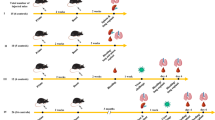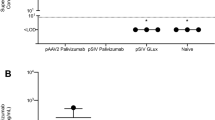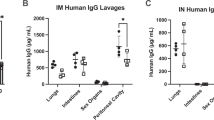Abstract
We demonstrated previously that the additive-type recombinant Sendai virus (rSeV) is highly efficient for use in pulmonary gene transfer; however, rSeV exhibits inflammatory responses. To overcome this problem, we tested newly developed non-transmissible constructs, namely, temperature-sensitive F-deleted vector, rSeV/dF (ts-rSeV/dF) and a rSeV with all the envelope-related genes deleted (rSeV/dFdMdHN), for pulmonary gene transfer in neonatal mice, by assessing their toxicity and immune responses. The gene expression in the lungs of neonatal ICR mice peaked on day 2, then gradually decreased until almost disappearing at 14 days after infection in all constructs. Loss of body weight and mortality rate, however, were dramatically improved in mice treated with SeV/dFdMdHN (mortality=0%, n=41) and ts-rSeV/dF (24.2%, n=33) compared with additive rSeV (70.7%, n=58). Although the deletion of envelope-related genes of SeV had a small impact on the production of antibody and cytotoxic T-lymphocyte activity in both adults and neonates, a dramatic reduction was found in the events related to innate responses, including the production of proinflammatory cytokines, particularly in the case of neonates. These results indicate that pulmonary gene transfer using SeV/dFdMdHN warrants further investigation for its possible use in developing safer therapeutics for neonatal lung diseases, including cystic fibrosis.
This is a preview of subscription content, access via your institution
Access options
Subscribe to this journal
Receive 12 print issues and online access
$259.00 per year
only $21.58 per issue
Buy this article
- Purchase on Springer Link
- Instant access to full article PDF
Prices may be subject to local taxes which are calculated during checkout







Similar content being viewed by others
References
Griesenbach U, Geddes DM, Alton EW . Gene therapy progress and prospects: cystic fibrosis. Gene Therapy 2006; 13: 1061–1077.
Tate S, Elborn S . Progress towards gene therapy for cystic fibrosis. Expert Opin Drug Deliv 2005; 2: 269–280.
Schwiebert LM . Cystic fibrosis, gene therapy, and lung inflammation: for better or worse? Am J Physiol Lung Cell Mol Physiol 2004; 286: L715–L716.
Ferrari S, Geddes DM, Alton EW . Barriers to and new approaches for gene therapy and gene delivery in cystic fibrosis. Adv Drug Deliv Rev 2002; 54: 1373–1393.
Kitson C, Angel B, Judd D, Rothery S, Severs NJ, Dewar A et al. The extra- and intracellular barriers to lipid and adenovirus-mediated pulmonary gene transfer in native sheep airway epithelium. Gene Ther 1999; 6: 534–546.
Crystal RG, Jaffe A, Brody S, Mastrangeli A, McElvaney NG, Rosenfeld M et al. A phase 1 study, in cystic fibrosis patients, of the safety, toxicity, and biological efficacy of a single administration of a replication deficient, recombinant adenovirus carrying the cDNA of the normal cystic fibrosis transmembrane conductance regulator gene in the lung. Hum Gene Ther 1995; 6: 643–666.
Knowles MR, Noone PG, Hohneker K, Johnson LG, Boucher RC, Efthimiou J et al. A double-blind, placebo controlled, dose ranging study to evaluate the safety and biological efficacy of the lipid-DNA complex GR213487B in the nasal epithelium of adult patients with cystic fibrosis. Hum Gene Therapy 1998; 9: 249–269.
Wagner JA, Nepomuceno IB, Messner AH, Moran ML, Batson EP, Dimiceli S et al. A phase II, double-blind, randomized, placebo-controlled clinical trial of tgAAVCF using maxillary sinus delivery in patients with cystic fibrosis with antrostomies. Hum Gene Therapy 2002; 13: 1349–1359.
Alton EW, Stern M, Farley R, Jaffe A, Chadwick SL, Phillips J et al. Cationic lipid-mediated CFTR gene transfer to the lungs and nose of patients with cystic fibrosis: a double-blind placebo-controlled trial. Lancet 1999; 353: 947–954.
Yonemitsu Y, Kitson C, Ferrari S, Farley R, Griesenbach U, Judd D et al. Efficient gene transfer to airway epithelium using recombinant Sendai virus. Nat Biotechnol 2000; 18: 970–973.
Shoji F, Yonemitsu Y, Okano S, Yoshino I, Nakagawa K, Nakashima Y et al. Airway-directed gene transfer of interleukin-10 using recombinant Sendai virus effectively prevents post-transplantation bronchiolitis obliterans in mice. Gene Therapy 2003; 10: 213–218.
Nagai Y . Paramyxovirus replication and pathogenesis. Reverse genetics transforms understanding. Rev Med Virol 1999; 9: 83–99.
Markwell MA, Svennerholm L, Paulson JC . Specific gangliosides function as host cell receptors for Sendai virus. Proc Natl Acad Sci USA 1981; 78: 5406–5410.
Moyer SA, Baker SC, Lessard JL . Tubulin: a factor necessary for the synthesis of both Sendai virus and vesicular stomatitis virus RNAs. Proc Natl Acad Sci USA 1986; 83: 5405–5409.
Li HO, Zhu YF, Asakawa M, Kuma H, Hirata T, Ueda Y et al. A cytoplasmic RNA vector derived from nontransmissible Sendai virus with efficient gene transfer and expression. J Virol 2000; 74: 6564–6569.
Waddington SN, Buckley SM, Bernloehr C, Bossow S, Ungerechts G, Cook T et al. Reduced toxicity of F-deficient Sendai virus vector in the mouse fetus. Gene Therapy 2004; 11: 599–608.
Larson JE, Cohen JC . Developmental paradigm for early features of cystic fibrosis. Pediatr Pulmonol 2005; 40: 371–377.
Inoue M, Tokusumi Y, Ban H, Kanaya T, Tokusumi T, Nagai Y et al. Nontransmissible virus-like particle formation by F-deficient Sendai virus is temperature sensitive and reduced by mutations in M and HN proteins. J Virol 2003; 77: 3238–3246.
Inoue M, Tokusumi Y, Ban H, Kato A, Nagai Y, Iida A et al. Further attenuation of gene(s)-deleted Sendai virus vectors: modification of transcription and replication caused weakened cytotoxicity. Mol Ther 2003; 7 (Suppl): S37 (Abstr).
Yoshizaki M, Hironaka T, Iwasaki H, Ban H, Tokusumi Y, Iida A et al. Naked Sendai virus vector lacking all of the envelope-related genes: reduced cytopathogenicity and immunogenicity. J Gene Med 2006; 8: 1151–1159.
Georgeson GD, Szony BJ, Streitman K, Kovacs A, Kovacs L, Laszlo A . Natural killer cell cytotoxicity is deficient in newborns with sepsis and recurrent infections. Eur J Pediatr 2001; 160: 478–482.
Tessier P, Naccache P, Clark-Lewis I, Gladue R, Neote K, McColl S . Chemokine networks in vivo: involvement of C-X-C and C-C chemokines in neutrophil extravasation in vivo in response to TNF-α. J Immunol 1997; 159: 3595–3602.
Frevert CW, Huang S, Danaee H, Paulauskis JD, Kobzik L . Functional characterization of the rat chemokine KC and its importance in neutrophil recruitment in a rat model of pulmonary inflammation. J Immunol 1995; 154: 335–344.
Adkins B . T-cell function in newborn mice and humans. Immunol Today 1999; 20: 330–335.
Kaplan J, Shope TC, Bollinger RO, Smith J . Human newborns are deficient in natural killer activity. J Clin Immunol 1982; 2: 350–355.
Gasparoni A, Ciardelli L, Avanzini A, Castellazzi AM, Carini R, Rondini G et al. Age-related changes in intracellular TH1/TH2 cytokine production, immunoproliferative T lymphocyte response and natural killer cell activity in newborns, children and adults. Biol Neonate 2003; 84: 297–303.
Cole GA, Hogg TL, Woodland DL . T cell recognition of the immunodominant Sendai virus NP324-332/Kb epitope is focused on the center of the peptide. J Immunol 1995; 155: 2841–2848.
Schnell MA, Zhang Y, Tazelaar J, Gao GP, Yu QC, Qian R et al. Activation of innate immunity in nonhuman primates following intraportal administration of adenoviral vectors. Mol Ther 2001; 3: 708–722.
Yonemitsu Y, Kaneda Y . Hemagglutinating virus of Japan-liposome-mediated gene delivery to vascular cells. In: Baker AH (ed). Molecular Biology of Vascular Diseases Methods in Molecular Medicine. Humana Press, Totowa, NJ, 1999, pp 295–306.
Yonemitsu Y, Kaneda Y, Morishita R, Nakagawa K, Nakashima Y, Sueishi K . Characterization of in vivo gene transfer into the arterial wall mediated by the HVJ-liposomes: an effective tool for in vivo study of arterial diseases. Lab Invest 1996; 75: 313–323.
Shibata S, Okano S, Yonemitsu Y, Onimaru M, Sata S, Nagata-Takeshita H et al. Induction of efficient antitumor immunity using dendritic cells activated by Sendai virus and its modulation of exogenous interferon-β gene. J Immunol 2006; 177: 3564–3576.
Kast WM, Bluestone JA, Heemskerk MH, Spaargaren J, Voordouw AC, Ellenhorn JD et al. Treatment with monoclonal anti-CD3 antibody protects against lethal Sendai virus infection by induction of natural killer cells. J Immunol 1990; 145: 2254–2259.
Acknowledgements
We thank Drs Mariko Yoshizaki, Akihiro Tagawa, Takumi Kanaya, Hiroshi Ban, and Takashi Hironaka for their excellent technical assistance with the construction and large-scale production of rSeV vectors, and to Ms Chie Arimatsu for her invaluable help with the animal experiments. This work was supported in part by a grant-in-aid (to YY and KS) from the Japanese Ministry of Education, Culture, Sports, Science, and Technology, and Research Grants from the Sankyo Foundation of Life Science (to YY), Mitsubishi Pharma Research Foundation (to YY), and Uehara Memorial Foundation (to YY).
Author information
Authors and Affiliations
Corresponding author
Rights and permissions
About this article
Cite this article
Tanaka, S., Yonemitsu, Y., Yoshida, K. et al. Impact of deletion of envelope-related genes of recombinant Sendai viruses on immune responses following pulmonary gene transfer of neonatal mice. Gene Ther 14, 1017–1028 (2007). https://doi.org/10.1038/sj.gt.3302955
Received:
Revised:
Accepted:
Published:
Issue Date:
DOI: https://doi.org/10.1038/sj.gt.3302955



